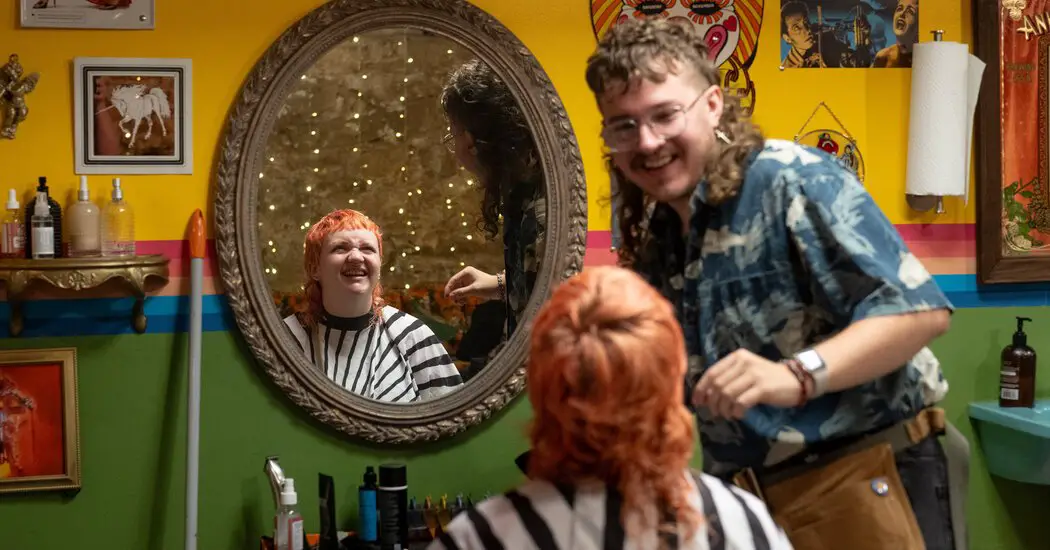Xavier Cruz and JP Gomez, a married gay couple, knew discrimination against the L.G.B.T.Q. community had become widespread. But as owners of Barba Grooming Boutique, a salon in Manhattan, they thought their industry was largely immune.
So in 2016, when they read a story about a trans man suing a California barbershop for denying him a haircut, they were spurred to action: With the help of Terri & Sandy, an ad agency, the two set up Strands for Trans, a nonprofit group that maps salons and barbershops that have explicitly pledged their support for transgender clients.
Mr. Cruz, 55, and Mr. Gomez, 37, initially called locations in New York asking if they would join, receiving some welcome publicity from their friend the fashion designer Marc Jacobs. But finding businesses in some areas proved more challenging. After two weeks (and hundreds of calls), the couple was able to recruit at least one member in each state.
Now, eight years later, Strands for Trans has expanded its membership to more than 4,900 locations across the United States, as far-reaching as Deep Cuts, in Duluth, Minn., and Goldenrod Parlor, in Gainesville, Fla.
Kai, 14, travels about an hour with his parents for his haircut at Goldenrod. It’s not for a lack of competent local barbers in Columbia County, Fla., where he lives; rather, Kai was in search of a stylist better attuned to the needs of trans boys like him — and he didn’t want to return to the one who had given him a style more suited for a middle-aged woman.
“I have been the person given the 45-year-old woman haircut,” said Avin Posen, Kai’s stylist.
Mr. Posen, 32, not only provided Kai with the cut he wanted — like “the TikTok boys from 2020,” Kai said — but was also the first trans adult he had met. “I didn’t see any trans people, even at school,” said Kai, whose parents asked that his last name not be used. “I was the only one.”
To join Strands for Trans, businesses must sign an agreement to respect their transgender clients. In exchange, the network provides educational workshops for members about how to make transgender and nonbinary people feel comfortable in their chairs.
Though there are a significant number of member salons in big coastal cities, they are far more sparse in rural counties like the one Kai lives in. Still, in states where gender transition care is being restricted, L.G.B.T.Q.-friendly salons are popping up with the specific intention of providing trans people with a good haircut.
Hannah McCann, a senior lecturer at the University of Melbourne who studies salons, said she “can’t overstate how important and profound it is” that spaces like Goldenrod exist in states with governments hostile to the L.G.B.T.Q. community.
“What people are communicating is, ‘I want to look a certain way, this is what makes me feel good in my body, and this person in the salon is the one that helps me do that,’” Professor McCann said.
Hairstyling is among the most elemental ways in which transgender people can feel more comfortable with their appearances. “When salons decide to be trans- and queer-affirming, I think that makes a lot of difference to people who often don’t feel safe bringing their bodies into public spaces,” said Kareem Khubchandani, an associate professor at Tufts University who studies the relationship between gender, sexuality and everyday aesthetics.
That’s partly because gender is baked into the infrastructure of salons. Women’s haircuts are typically more expensive than men’s. Many places specialize in only one gender, let alone those who fall outside the gender binary. And some transgender and nonbinary people say stylists have outright refused their requests because of their gender identity.
“I’ve gone into other places asking for a trim and to get my sides re-buzzed, and ended up with three or four inches cut off,” said Morrighan Nyx, a 25-year-old transgender woman, who now exclusively patronizes Mullet Proof, a salon in Boise, Idaho, that is a member of Strands for Trans.
Noah Neumeister, 25, Mullet Proof’s owner, described his work as “more than just doing hair.” In April 2023, after the state’s Republican governor signed legislation banning gender transition care for people under 18, Mullet Proof hosted an event to provide free haircuts for those affected.
That kind of inclusivity brought Zeth Roark, who is nonbinary and uses they and them pronouns, into Mullet Proof for their first haircut in two years. “My hair looked pretty bad, honestly,” Mx. Roark, 23, said. After their initial appointment, “I actually felt good about a haircut for once in my life,” they said. “Mullet Proof is a place where you feel safe to be yourself. It’s a little cliché, but it’s the truth.”
Most salons that are members of Strands for Trans are not trans-owned, and some of the hairstylists, despite good intentions, are unfamiliar with the use of inclusive language.
Kitt Spata, who helps train salons that are part of the network, said that a majority of the work involves challenging stylists to think beyond the gendered language endemic in hair styling. Instead of calling certain styles “masculine,” they’ll suggest “bold”; likewise, they’ll substitute “soft” for “feminine.”
“It can be hard at first to avoid using gendered terms,” Mx. Spata, 26, said. “But there are many more terms to use that can make hair styling feel more artistic.”
Olivia Noel, 27, who visits Goldenrod to get her cut in a shag, is currently one of the plaintiffs suing Florida over a law restricting access to gender transition care for adults. The salon, she said, helps her feel a little less alone.
“That’s not even getting into the amazing work they do,” she continued. “My hair has never looked better.”

